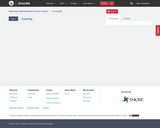
200 Results

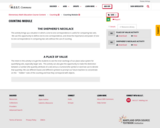
- Subject:
- Elementary Education
- Mathematics
- Material Type:
- Module
- Author:
- OER Librarian
- Date Added:
- 05/07/2021
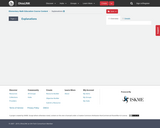
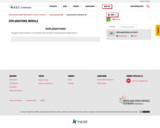
- Subject:
- Elementary Education
- Material Type:
- Module
- Author:
- OER Librarian
- Date Added:
- 05/07/2021

The applet in this section allows you see how probabilities are determined from the exponential distribution. The user determines the mean of the distribution and the limits of probability. Three different probability expressions are available.
- Subject:
- Mathematics
- Statistics and Probability
- Material Type:
- Activity/Lab
- Provider:
- Consortium for the Advancement of Undergraduate Statistics Education
- Provider Set:
- Causeweb.org
- Author:
- Anderson-Cook, C.
- C. Anderson-Cook
- Dorai-Raj, S.
- Robinson, T.
- S. Dorai-Raj
- T. Robinson
- Date Added:
- 05/23/2019
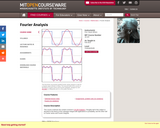
Continues 18.100. Roughly half the subject devoted to the theory of the Lebesgue integral with applications to probability, and half to Fourier series and Fourier integrals.
- Subject:
- Mathematics
- Material Type:
- Full Course
- Provider:
- M.I.T.
- Provider Set:
- M.I.T. OpenCourseWare
- Author:
- Melrose, Richard B.
- Date Added:
- 01/01/2004

This open-source book by Crowell, Robbin, and Angenent is a spin-off of a previous open-source book by Robbin and Angenent. It covers the first semester of a freshman calculus course.
- Subject:
- Calculus
- Mathematics
- Material Type:
- Textbook
- Provider:
- Light and Matter
- Provider Set:
- Light and Matter Books
- Author:
- Crowell, Robin and Angenent
- Date Added:
- 05/22/2019
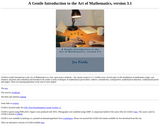
This book is designed for the transition course between calculus and differential equations and the upper division mathematics courses with an emphasis on proof and abstraction. The book has been used by the author and several other faculty at Southern Connecticut State University. There are nine chapters and more than enough material for a semester course. Student reviews are favorable.
It is written in an informal, conversational style with a large number of interesting examples and exercises, so that a student learns to write proofs while working on engaging problems.
- Subject:
- Mathematics
- Material Type:
- Textbook
- Provider:
- Southern Connecticut State University
- Date Added:
- 05/22/2019
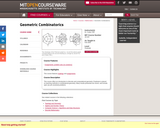
Introduction to discrete and computational geometry. Topics covered: planar graphs, geometric graphs, the theory of crossings, extremal graph theory, arrangements of curves and points in the plane (mainly pseudolines and pseudocircles), problems involving distances, Gallai-Sylvester-type problems, Davenport-Schinzel sequences. Emphasis on teaching methods in combinatorial geometry. Many results presented are recent, and include open problems.
- Subject:
- Mathematics
- Material Type:
- Full Course
- Provider:
- M.I.T.
- Provider Set:
- M.I.T. OpenCourseWare
- Author:
- Toth, Csaba
- Date Added:
- 01/01/2005
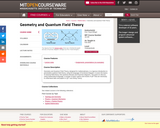
A rigorous introduction designed for mathematicians into perturbative quantum field theory, using the language of functional integrals. Basics of classical field theory. Free quantum theories. Feynman diagrams. Renormalization theory. Local operators. Operator product expansion. Renormalization group equation. The goal is to discuss, using mathematical language, a number of basic notions and results of QFT that are necessary to understand talks and papers in QFT and string theory.
- Subject:
- Calculus
- Mathematics
- Material Type:
- Full Course
- Provider:
- M.I.T.
- Provider Set:
- M.I.T. OpenCourseWare
- Author:
- Etingof, Pavel I.
- Date Added:
- 01/01/2002
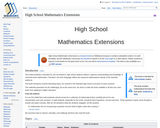
This online textbook is intended for, but not limited to, 14 to 18 year old teenagers who have a general interest in mathematics. The text's language is aimed at high school students without a rigorous understanding and knowledge of university-level mathematics.
This book introduces several interesting topics not covered in the standard high school curriculum of most countries.
The materials presented can be challenging, but at the same time, we strive to make this book readable to all with 9–10 years of formal education.
- Subject:
- Mathematics
- Material Type:
- Textbook
- Provider:
- Wikibooks
- Date Added:
- 05/22/2019
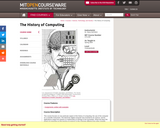
Examines the development of computing techniques and technology in the nineteenth and twentieth centuries, particularly critical evaluation of how the very idea of "computer" changes and evolves over time. Emphasis is on technical innovation, industrial development, social context, and the role of government. Topics include Babbage, Hollerith, differential analyzers, control systems, ENIAC, radar, operations research, computers as scientific instruments, the rise of "computer science," artificial intelligence, personal computers, and networks. Includes class visits by members of the MIT community who have made important historical contributions. This course focuses on one particular aspect of the history of computing: the use of the computer as a scientific instrument. The electronic digital computer was invented to do science, and its applications range from physics to mathematics to biology to the humanities. What has been the impact of computing on the practice of science? Is the computer different from other scientific instruments? Is computer simulation a valid form of scientific experiment? Can computer models be viewed as surrogate theories? How does the computer change the way scientists approach the notions of proof, expertise, and discovery? No comprehensive history of scientific computing has yet been written. This seminar examines scientific articles, participants' memoirs, and works by historians, sociologists, and anthropologists of science to provide multiple perspectives on the use of computers in diverse fields of physical, biological, and social sciences and the humanities. We explore how the computer transformed scientific practice, and how the culture of computing was influenced, in turn, by scientific applications.
- Subject:
- Applied Science
- Computer Science
- Linguistics
- Social Science
- Material Type:
- Full Course
- Provider:
- M.I.T.
- Provider Set:
- M.I.T. OpenCourseWare
- Author:
- Gerovitch, Slava
- Date Added:
- 01/01/2004
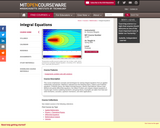
Selection of material from the following topics: calculus of variations (the first variation and the second variation); integral equations (Volterra equations; Fredholm equations, the Hilbert-Schmidt theorem); the Hilbert Problem and singular integral equations of Cauchy type; Wiener-Hopf Method and partial differential equations; Wiener-Hopf Method and integral equations; group theory.
- Subject:
- Algebra
- Mathematics
- Material Type:
- Full Course
- Provider:
- M.I.T.
- Provider Set:
- M.I.T. OpenCourseWare
- Author:
- Margetis, Dionisios
- Date Added:
- 01/01/2006
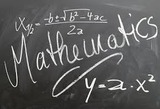
Intermediate algebra is a course designed for students who have successfully completed high school algebra but who placed into pre-college level mathematics at Garrett College. This course is for refreshing math skills with a review of pre-college level algebra. After successfully completing this course, the student should be prepared to go on to College Algebra.
- Subject:
- Algebra
- Mathematics
- Material Type:
- Assessment
- Full Course
- Homework/Assignment
- Author:
- Cassandra Frandsen
- Date Added:
- 12/21/2021
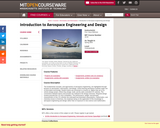
" The fundamental concepts, and approaches of aerospace engineering, are highlighted through lectures on aeronautics, astronautics, and design. Active learning aerospace modules make use of information technology. Student teams are immersed in a hands-on, lighter-than-air (LTA) vehicle design project, where they design, build, and fly radio-controlled LTA vehicles. The connections between theory and practice are realized in the design exercises. Required design reviews precede the LTA race competition. The performance, weight, and principal characteristics of the LTA vehicles are estimated and illustrated using physics, mathematics, and chemistry known to freshmen, the emphasis being on the application of this knowledge to aerospace engineering and design rather than on exposure to new science and mathematics."
- Subject:
- Astronomy
- Chemistry
- Physical Science
- Physics
- Material Type:
- Full Course
- Provider:
- M.I.T.
- Provider Set:
- M.I.T. OpenCourseWare
- Author:
- Newman, Dava
- Date Added:
- 01/01/2003
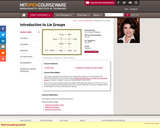
A general introduction to manifolds and Lie groups. The role of Lie groups in mathematics and physics. The exponential mapping. Correspondence with Lie algebras. Homogeneous spaces and transformation groups. Adjoint representation. Covering groups. Automorphism groups. Invariant differential forms and cohomology of Lie groups and homogeneous spaces. 18.101 recommended but not required. DThis course is devoted to the theory of Lie Groups with emphasis on its connections with Differential Geometry. The text for this class is Differential Geometry, Lie Groups and Symmetric Spaces by Sigurdur Helgason (American Mathematical Society, 2001). Much of the course material is based on Chapter I (first half) and Chapter II of the text. The text however develops basic Riemannian Geometry, Complex Manifolds, as well as a detailed theory of Semisimple Lie Groups and Symmetric Spaces.
- Subject:
- Mathematics
- Material Type:
- Full Course
- Provider:
- M.I.T.
- Provider Set:
- M.I.T. OpenCourseWare
- Author:
- Helgason, Sigurdur
- Date Added:
- 01/01/2004
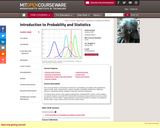
Elementary introduction with applications. Basic probability models. Combinatorics. Random variables. Discrete and continuous probability distributions. Statistical estimation and testing. Confidence intervals. Introduction to linear regression.
- Subject:
- Mathematics
- Material Type:
- Full Course
- Provider:
- M.I.T.
- Provider Set:
- M.I.T. OpenCourseWare
- Author:
- Jeremy Orloff
- Jonathan Bloom
- Date Added:
- 01/01/2014
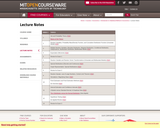
This course is a self-contained introduction to statistics with economic applications. Elements of probability theory, sampling theory, statistical estimation, regression analysis, and hypothesis testing. It uses elementary econometrics and other applications of statistical tools to economic data. It also provides a solid foundation in probability and statistics for economists and other social scientists.
- Subject:
- Economics
- Mathematics
- Social Science
- Material Type:
- Full Course
- Provider:
- M.I.T.
- Provider Set:
- M.I.T. OpenCourseWare
- Author:
- MIT
- Prof. Sara Ellison
- Date Added:
- 05/23/2019
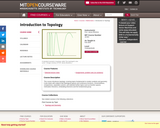
Introduces topology, covering topics fundamental to modern analysis and geometry. Topological spaces and continuous functions, connectedness, compactness, separation axioms, and selected further topics such as function spaces, metrization theorems, embedding theorems, the Tychonoff theorem.
- Subject:
- Mathematics
- Material Type:
- Full Course
- Provider:
- M.I.T.
- Provider Set:
- M.I.T. OpenCourseWare
- Author:
- Munkres, James
- Date Added:
- 01/01/2004
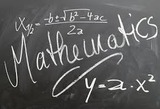
This course will introduce basic algebra skills to students with limited background in algebra. Topics covered will include order of operations, computations with real numbers and linear equations and problem solving. The course will introduce operations with: integers, exponents, fractions, decimals, and percents. More advance algebra concepts will include model building and analysis of graphical and numerical data with an emphasis on making connections between concepts learned in the classroom and real-world applications. An emphasis will be placed on using proportions to solve real world problems.
- Subject:
- Algebra
- Mathematics
- Material Type:
- Assessment
- Full Course
- Homework/Assignment
- Author:
- Cassandra Frandsen
- Date Added:
- 12/21/2021